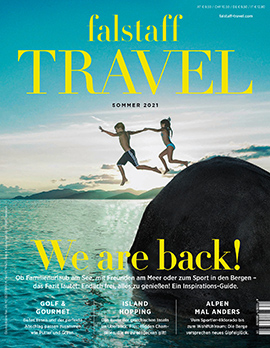
The Art of Building: Architecture in Tyrol
Between avant-garde, tradition and a new mindfulness: Tyrol's architecture is as striking as its rugged mountains and as idiosyncratic as its people. It has always had the courage to try something new, but remains very much aware of its cultural heritage.
July 23, 2024
The Bergisel ski jump by Zaha Hadid - there's a panorama café and terrace in the jump tower. © provided
A fascination with mountain peaks isn't really surprising in the case of the British-Iraqi architect Zaha Hadid, who died in 2016. Her futuristic buildings often look like UFOs making a stopover on our planet. So why not land in the Alps? Thanks to her, there's the Messner Mountain Museum in Northern Italy, which digs deep into the mountain; with the curved Hungerburgbahn, connecting Innsbruck with the mountain world, and the Bergisel ski jump, she has also created two important landmarks in Tyrol. The ski jump tower, which today houses a panorama café and terrace with breathtaking views, opened in 2002. In Tyrol, Hadid proved that architecture can adapt perfectly to the rugged local landscape, while at the same time developing international appeal.
Alpine houses on the Oberstalleralm in East Tyrol, which is also a popular hiking area. Matjaz Corel / Alamy Stock Photo
Functionality and practicality have always been at the heart of Tyrolean building. However, this isn't immediately apparent in the traditional Alpine farmhouses with their ornately carved wooden balconies, which are often adorned with lush flowers. They usually have a brick first floor and wooden superstructures that age beautifully. The balconies were used for hanging laundry and drying herbs; everything had its place. The courtyards provided living and utility rooms that ensured the survival of the families.
Tyrolean modernity
Centerpiece in the garden of Swarovski Crystal Worlds: the crystal clouds by Andy Cao and Xavier Perrot. © Little valleys / Alamy Stock Photo
In the 1920s and 1930s, Tyrolean architects such as Clemens Holzmeister and Lois Welzenbacher drew on international trends such as New Objectivity. As representatives of Tyrolean modernism, they focused on buildings that should be as unadorned as possible. The sacred buildings of Clemens Holzmeister, who also built many hotels in Tyrol, such as Hotel Post in St. Anton with its pyramid roof, characterizing the townscape, or the hotel Drei Zinnen in Sexten, are positioned between simplicity and expressionism. Building materials from the surrounding area were used - sustainable construction was, of course, in a region defined by harsh winters and self-sufficient farms a great importance. "Conscious design. Create values. Build the future." The motto of the young Innsbruck-based collective Snow Architektur takes traditional values and construction methods into the future. Clarity, transparency and lightness characterize many new Tyrolean buildings, and wood is once again a central theme.
Black diamond
The exterior of the Festspielhaus Erl looks like a black diamond; the concert hall is lined with wood. Brigida González
Tyrol invests a lot in innovative culture - and no compromises are made when it comes to architecture. After all, buildings are there for people to talk about them, to relate to them. Festspielhaus Erl by Viennese architecture firm Delugan Meissl Associated Architects looks like a black diamond that stands in creative tension with the white Passion Playhouse. This exciting dialog with the landscape and the buildings that already exist distinguishes successful architecture from superficial architecture that could stand anywhere and tells nothing.
In contrast to the concert hall of the Festspielhaus Erl, the foyer shines in white © Cornelia Hoschek
Haus der Musik in Innsbruck, designed by Erich Strolz and realized in collaboration with Dietrich Untertrifaller Architekten from Bregenz, which opened in 2018, also caused some debate initially. It was dubbed the "Kaaba of Innsbruck" due to the dark ceramic slats on the façade. However, Strolz deliberately didn't want to design a light-colored building because most museums and theaters are like this anyway. Instead, the high-quality, movable slats were intended to reflect the surroundings. The ceramic shell itself shimmers reddish-brownish to aubergine-colored depending on the lighting conditions, the dark exterior contrasting with the light interior.
The ceramic shell of the Haus der Musik in Innsbruck shimmers reddish-brownish to aubergine-colored depending on the light conditions. © Guenther Egger
In Tyrol, nature shapes construction, whether in traditional timber construction or with modern approaches, embracing the ruggedness of the landscape. One striking example is the garnet chapel on the Penkenjoch - the architect Mario Botta, who comes from the Swiss canton of Ticino, was inspired by the shape of the garnet stone that was quarried here, as well as the wood from the region. The garnet was traditionally cut in the shape of a rhombic dodecahedron and worn with traditional costumes. The way in which the chapel is enthroned on a rocky outcrop above the valley has something unreal about it.
© norbert-freudenthaler.com
The interior is lined with larch wood and natural light streams in through an opening in the ceiling. The chapel can only be visited in the summer months, but photos in a snowy winter landscape make it look even more like a spaceship. Just like the bold buildings by Zaha Hadid, which even years after they were built seem to have been beamed here from the future. The impressive mountain world of Tyrol is an ideal place to let them shine. As a person, here you feel small and insignificant anyway - which can be uplifting.
The Garnet Chapel on the Penkenjoch has the shape of a rhombic dodecahedron, which used to be worn with traditional costumes. Credit: Allan Hartley / Alamy Stock Photo
Read more: Design hotels in Tyrol: understated elegance

This article appeared in the Falstaff TRAVEL issue Tirol Special 2024.









